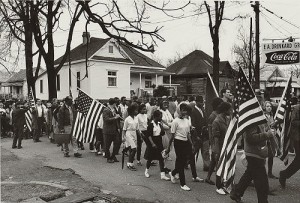 Today is the 50th anniversary of “Bloody Sunday,” the day when Civil Rights demonstrators tried to march to Montgomery, Alabama, from Selma on the Jefferson Davis Highway. At the Edmund Pettus Bridge (named for a Confederate brigadier general, Alabama state senator, and the Grand Dragon of the KKK), the unarmed marchers were violently attacked by state troopers and a Dallas County posse. They were harassed with billy clubs, tear gas, and homemade weapons. Activist Amelia Boynton was beaten unconscious and many others were brutalized. The event was captured by the media and captivated the nation.
Today is the 50th anniversary of “Bloody Sunday,” the day when Civil Rights demonstrators tried to march to Montgomery, Alabama, from Selma on the Jefferson Davis Highway. At the Edmund Pettus Bridge (named for a Confederate brigadier general, Alabama state senator, and the Grand Dragon of the KKK), the unarmed marchers were violently attacked by state troopers and a Dallas County posse. They were harassed with billy clubs, tear gas, and homemade weapons. Activist Amelia Boynton was beaten unconscious and many others were brutalized. The event was captured by the media and captivated the nation.
Two days later, on March 9, a second march took place, this time led by Martin Luther King Jr. Law enforcement allowed the protestors to pass, but King insisted the marchers return to the church. Later that night, Unitarian Universalist minister James Reeb was murdered by white supremacists. President Lyndon B. Johnson agreed to protect the protestors after Governor George Wallace refused. Two years prior in his inaugural speech, Wallace stood on the spot where Jefferson Davis was sworn in as President of the Confederate States and said, “In the name of the greatest people that have ever trod this earth, I draw the line in the dust and toss the gauntlet before the feet of tyranny, and I say segregation now, segregation tomorrow, segregation forever.” Shortly thereafter, Wallace also ran a failed campaign to block four Black schoolchildren from desegregating Huntsville, Alabama, and spent much of his gubernatorial tenure trying to prevent desegregation. Wallace regretted his racism in later years, and asked for forgiveness from the African American community.
It was not until March 21 that the civil rights protestors were finally able to commence their march to the capital. What began as 600 marchers on March 7 grew to 25,000 by March 21. The march ended on a tragic note, however, when white ally Viola Liuzzo, a mother of five from Detroit who had been in Selma to support the protestors, was assassinated by the KKK while driving marchers back to Selma. The marches were instrumental in turning the tide against segregation, and helped President Johnson pass his Voting Rights Act of 1965, a watershed moment in Civil Rights. It would not be the end of the movement, but it did mark a giant step forward in American history.
In Napa, the Napa Register was not printed on March 7, but for the next two days the events in Selma were covered, albeit only briefly. The famous photo of Boynton being carried off the bridge appeared in the paper, as did two short articles by the Associated Press, one on March 8 and the other on March 9.
To learn more about African American history in Napa and California:
Negro Trail-Blazers of California by Delilah Beasley
John Grider’s Century by Sharon McGriff-Payne


